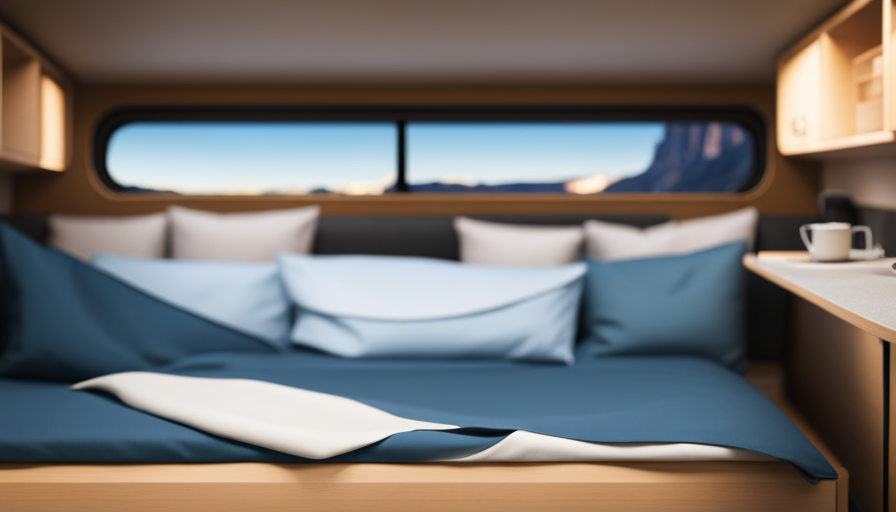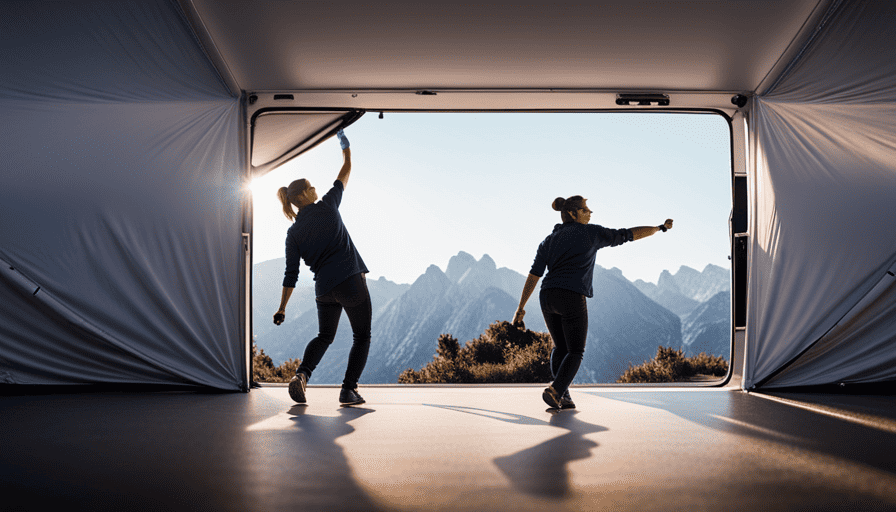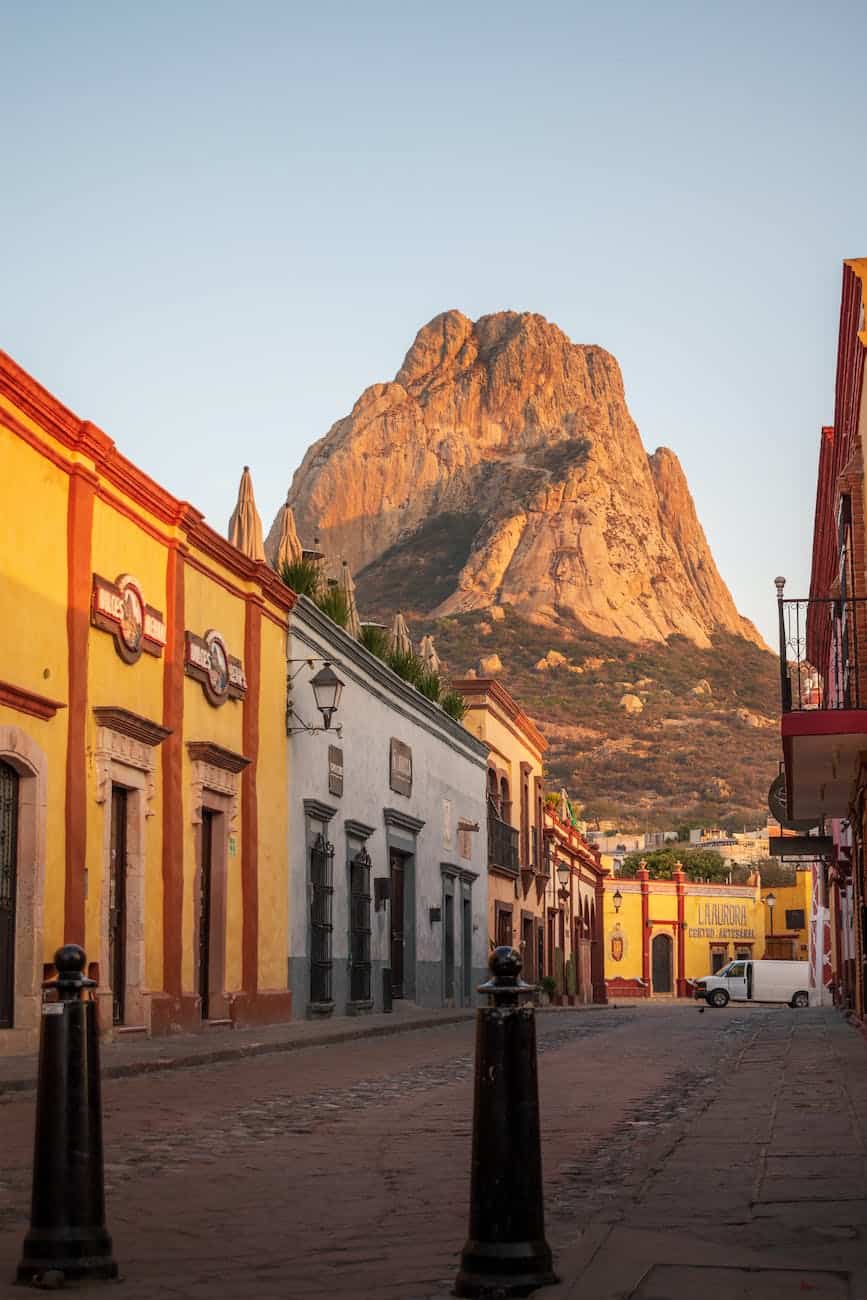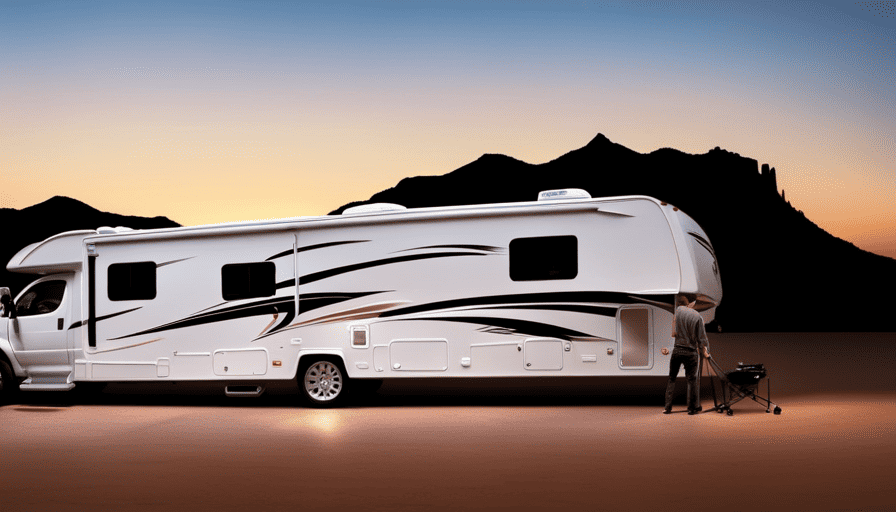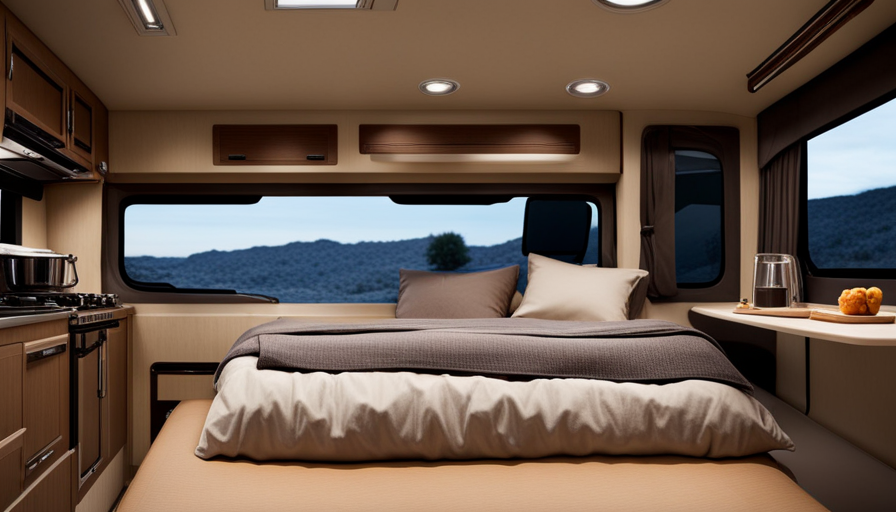Constructing a camper van is akin to starting an adventure in crafting your own cozy mobile abode. It demands meticulous planning, financial management, and a strong sense of style.
As with any journey, it’s important to have a roadmap, which is why I’m here to guide you through the process and give you an idea of how much it will cost to build your dream camper van.
Imagine a blank canvas, a van waiting to be transformed into your personalized sanctuary on wheels. From choosing the right van to designing the layout, every step of the way requires thoughtful consideration. And of course, there’s the matter of budgeting.
How much should you set aside for the van purchase, insulation, electrical installation, and all the other components that make a camper van functional and comfortable?
In this article, we will delve into the various aspects of building a camper van, exploring the costs associated with each stage. So, fasten your seatbelt and get ready to embark on this adventure of creating your own mobile oasis.
Key Takeaways
- Choosing the right van size is crucial, considering the number of people traveling and space needed.
- Budgeting for the van purchase is important, considering factors like brand, model, age, and condition.
- Designing the layout requires maximizing comfort, efficiency, and storage.
- Electrical and plumbing installation is crucial for a functional living space, considering electrical wiring, water system, safety considerations, and professional help.
Choosing the Right Van
You’ll be amazed at how much joy and freedom you’ll feel when you find the perfect van for your dream camper conversion. The first step in building a camper van is choosing the right van size that suits your needs and preferences.
Consider how many people will be traveling with you and how much space you require for sleeping, cooking, and storage. Smaller vans like the Ford Transit Connect or the Mercedes-Benz Metris offer a compact size that’s easier to maneuver and park, while larger vans like the Mercedes-Benz Sprinter or the Ford Transit provide more room for interior customization.
When it comes to interior customization, the possibilities are endless. You can design your camper van to have a cozy sleeping area, a functional kitchenette, and even a compact bathroom. Think about the features that are important to you and make a list of the must-haves for your ideal camper van. Consider the layout, materials, and storage options that’ll best suit your lifestyle and travel needs.
Now that you have an idea of the van size and interior customization you want, it’s time to move on to budgeting for the van purchase. The cost of the van will depend on factors such as the brand, model, age, and condition. By setting a budget and researching different options, you can find a van that fits your needs and your wallet.
Budgeting for the Van Purchase
Planning your dream road trip home on wheels is like embarking on a treasure hunt, carefully budgeting for the ultimate vehicle purchase.
When it comes to choosing the right van for your camper conversion, there are a few things to consider. Firstly, think about the size and layout that would best suit your needs. Are you looking for a compact van that’s easy to maneuver or a larger one that offers more space?
Additionally, think about the age and condition of the van. While older vans may be more affordable, they may require more maintenance and repairs in the long run.
Once you have narrowed down your options, it’s time to think about financing. Buying a van outright can be quite expensive, so exploring financing options is a smart move. Consider getting a loan from a bank or credit union, as they often offer competitive interest rates for vehicle purchases.
Another option is to lease a van, which allows you to pay a monthly fee without the commitment of owning the vehicle.
As you begin to plan and design the layout for your camper van, keep in mind the van selection and financing options you’ve chosen. This will help guide your decisions and ensure that you stay within your budget.
Planning and Designing the Layout
When considering the layout for your dream road trip home on wheels, envision a space that maximizes comfort, efficiency, and storage, creating a cozy haven on the go. Space optimization is key in a camper van, and careful planning can make a small area feel much larger than it actually is.
Here are some tips to help you design a layout that meets your needs:
-
Utilize multi-functional furniture: Incorporate pieces that can serve multiple purposes, such as a bed that doubles as seating or a table that can be folded away when not in use.
-
Maximize vertical space: Install shelves or cabinets that reach up to the ceiling to make the most of every inch of storage.
-
Consider modular storage solutions: Opt for bins or baskets that can be easily moved around or stacked to accommodate different items and keep everything organized.
-
Create designated zones: Divide your van into specific areas for sleeping, cooking, and lounging to create a sense of order and maximize efficiency.
By planning and designing your layout with these space optimization and storage solutions in mind, you can create a functional and comfortable living space in your camper van. With this foundation in place, the next step is to consider insulation and ventilation costs, ensuring a comfortable environment regardless of the weather.
Insulation and Ventilation Costs
To ensure a comfortable living environment in your dream mobile home, it’s important to consider the costs of insulation and ventilation.
Insulation materials play a crucial role in regulating temperature inside the camper van, preventing heat loss during winter and heat gain during summer. The cost of insulation materials can vary depending on the type and quality you choose.
Common options include foam board, spray foam, and reflective insulation. Foam board insulation is typically the most affordable, while spray foam provides better insulation but comes at a higher cost. Reflective insulation is great for blocking radiant heat but may not be sufficient on its own.
Ventilation systems are equally important to maintain fresh air circulation and prevent condensation buildup. Installing windows and roof vents can help achieve this, but additional features like fans or air conditioning units may be necessary for optimal comfort. The cost of ventilation systems will depend on the type and brand you select, as well as any additional features you desire.
With insulation and ventilation costs addressed, the next step is to consider the expenses associated with electrical and plumbing installation.
Electrical and Plumbing Installation
Don’t overlook the importance of proper electrical and plumbing installation for creating a functional and efficient living space in your dream mobile home. When it comes to camper van conversions, ensuring that your electrical wiring and water system are installed correctly is crucial for a comfortable and hassle-free experience on the road.
Here are four key factors to consider when it comes to electrical and plumbing installation:
-
Electrical wiring: A well-designed electrical system is essential for powering your appliances, lighting, and other electrical devices in the van. It’s important to plan your electrical layout carefully, considering the power requirements of each component and ensuring that you have sufficient outlets and switches in convenient locations.
-
Water system: Installing a reliable water system is essential for cooking, cleaning, and personal hygiene in your camper van. This includes a freshwater tank, a water pump, and a sink with plumbing connections. You may also want to consider adding a hot water heater for added convenience.
-
Safety considerations: It’s crucial to ensure that all electrical and plumbing installations meet safety standards and are properly insulated to prevent any potential hazards. This includes using appropriate wiring, circuit breakers, and fuses, as well as proper sealing and ventilation for your water system.
-
Professional help: If you’re not experienced in electrical and plumbing work, it’s highly recommended to seek professional help to ensure that everything is installed correctly and safely.
Now, let’s move on to the next section about furnishing and upholstery expenses, where we’ll explore how to create a comfortable and stylish interior for your camper van.
Furnishing and Upholstery Expenses
Make your dream mobile home truly shine by splurging on luxurious furnishings and plush upholstery that’ll transform your living space into a cozy oasis on wheels. When it comes to furnishing your camper van, there are various upholstery techniques that can add a touch of elegance and comfort to your interior.
Consider using high-quality fabrics such as leather or velvet, as they not only look stylish but are also durable and easy to clean. Additionally, investing in comfortable cushions and mattresses will ensure a good night’s sleep during your travels.
While creating a luxurious interior is exciting, it’s essential to keep your budget in mind. Luckily, there are cost-saving tips you can follow to achieve a high-end look without breaking the bank. One option is to repurpose or upcycle furniture and upholstery materials. You can find great deals at thrift stores or online marketplaces and give them a fresh new look with some DIY techniques.
Another way to save money is by choosing quality materials that are reasonably priced, such as faux leather or microfiber.
Now that you have your living space furnished and upholstered, it’s time to move on to the next step: kitchen and bathroom fixtures.
Kitchen and Bathroom Fixtures
Now that you’ve created a luxurious and cozy interior for your dream mobile home, let’s talk about the essential kitchen and bathroom fixtures that’ll make your on-the-go lifestyle a breeze.
For the kitchen, investing in high-quality equipment is key. A compact yet efficient stove with multiple burners will allow you to cook your favorite meals on the road. Don’t forget to include a refrigerator to keep your food fresh and a sink for easy cleanup. Having a well-stocked pantry with compact storage containers will ensure you always have the ingredients you need.
In the bathroom, maximizing storage space is crucial. Consider installing a vanity with drawers or shelves to keep your toiletries organized. A shower with adjustable water pressure and a water-saving feature will provide a refreshing bathing experience while conserving water. Additionally, having a composting toilet or a portable toilet with waste disposal options will make bathroom breaks hassle-free.
Now that you have all the necessary fixtures, let’s move on to the next section about solar power and off-grid options. With these additions, you can enjoy the freedom of traveling while still having all the comforts of home.
Solar Power and Off-Grid Options
While it may seem expensive at first, investing in solar power for your mobile home can provide long-term savings and environmental benefits. Solar panels are a great addition to any camper van as they allow you to generate your own electricity and reduce your reliance on traditional power sources. When considering solar power options for your camper van, it’s important to understand solar panel efficiency and battery capacity.
Solar panel efficiency refers to how effectively the panels convert sunlight into electricity. Higher efficiency panels will produce more power in the same amount of sunlight, allowing you to generate more electricity for your camper van. Battery capacity, on the other hand, determines how much energy can be stored for later use. A higher capacity battery will allow you to power more appliances and devices for a longer period of time.
To help you understand the importance of solar panel efficiency and battery capacity, here is a table that compares different options:
| Solar Panel Efficiency | Battery Capacity |
|---|---|
| Option 1 | Option 1 |
| Option 2 | Option 2 |
| Option 3 | Option 3 |
Investing in solar power and off-grid options for your camper van can provide numerous benefits. Not only will you save money in the long run, but you’ll also reduce your carbon footprint and have the freedom to travel without worrying about finding power sources. In the next section, we will discuss maintenance and repairs to ensure your camper van stays in top shape.
Maintenance and Repairs
Taking care of your mobile home is essential to ensure it remains in optimal condition for your travels. Regular maintenance and timely repairs are key to keeping your camper van running smoothly. When it comes to maintenance costs, it’s important to budget for routine tasks such as oil changes, tire rotations, and brake inspections. These regular maintenance tasks help prevent costly repairs down the road. Additionally, you should also factor in the costs of replacing filters, belts, and fluids as part of your regular maintenance schedule.
In terms of common repairs, it’s important to be prepared for potential issues that may arise during your travels. Common repairs for camper vans include fixing plumbing leaks, electrical problems, or issues with the engine. It’s a good idea to have a basic understanding of these systems and carry essential tools and spare parts to address minor repairs on the go. However, for major repairs or complex issues, it’s recommended to seek professional help to ensure the job is done correctly.
Transitioning into the subsequent section about ‘additional accessories and upgrades,’ it’s important to consider these factors when planning for your camper van.
Additional Accessories and Upgrades
To really take your mobile home to the next level, why not consider adding some extra flair and upgrades? It’s like giving your camper wings to soar!
One popular upgrade option is installing roof racks. These racks provide additional storage space for bulky items such as bikes, kayaks, or camping gear. They’re typically made of sturdy materials like aluminum or steel and can be easily mounted onto the roof of your camper van. Roof racks not only increase storage capacity, but they also enhance the overall functionality and versatility of your vehicle.
Another accessory that can greatly enhance your camper van experience is an awning. Awning options come in a variety of styles and sizes, allowing you to create a comfortable outdoor living space. Whether you’re seeking shade on a sunny day or protection from the rain, an awning can provide the perfect solution. Some awnings can even be extended to create a cozy outdoor room complete with walls and windows. Additionally, many awnings come equipped with LED lights, making it possible to enjoy your outdoor space even after the sun goes down.
By adding roof racks and exploring different awning options, you can truly customize your camper van to meet your specific needs and desires. These upgrades not only enhance the functionality of your vehicle but also add a touch of style and comfort to your mobile home on wheels. So why not take your camper van to new heights with these exciting accessories?
Frequently Asked Questions
Can I use any type of van to build a camper van?
Yes, you can convert various types of vans into a camper van. When choosing the right van for your conversion, consider factors like size, maneuverability, and interior space. Some popular options include cargo vans, passenger vans, and even school buses. However, converting a school bus into a camper van requires additional planning due to its larger size.
It’s essential to carefully consider your needs and preferences before deciding which van is best suited for your camper van conversion.
How much does it cost to convert a van into a camper van?
Cost considerations and budgeting are important factors when converting a van into a camper van. DIY conversions can be cost-effective, requiring only the necessary materials and tools. However, professional conversions offer expertise and convenience at a higher cost.
The price range for a camper van conversion varies depending on factors such as the size of the van, desired amenities, and the level of customization. It’s crucial to carefully plan and research to ensure the conversion fits within your budget.
What permits or licenses do I need to convert a van into a camper van?
To legally convert a van into a camper van, there are a few permits and licenses you need to consider.
First, check with your local Department of Motor Vehicles (DMV) for specific requirements in your area. Generally, you may need a special vehicle license, as well as permits for modifications like installing a kitchen or bathroom.
Additionally, make sure to comply with safety regulations, such as proper ventilation and electrical systems.
How long does it typically take to convert a van into a camper van?
On average, converting a van into a camper van takes around 2-3 months. However, the timeframe can vary depending on various factors such as the complexity of the conversion, the availability of resources, and the skills of the person undertaking the project.
Common challenges during the conversion process include electrical wiring, plumbing, insulation, and furniture installation. Proper planning, research, and patience are key to ensuring a successful and timely conversion.
Are there any specific safety regulations I need to consider when building a camper van?
When it comes to building a camper van, there are indeed specific safety regulations that need to be considered. It’s crucial to ensure that your vehicle meets the necessary standards for things like electrical systems, gas installations, and fire safety.
Additionally, it’s important to follow proper construction techniques to ensure structural integrity and stability. By adhering to these regulations and techniques, you can create a camper van that isn’t only comfortable but also safe for your travels.
What is the Cost of Converting a Van to a Camper?
Converting a van to a camper can vary in cost depending on various factors. The cost of materials, labor, and additional features can all influence the overall expenses. Customizing the interior, installing electrical and plumbing systems, and adding insulation are essential components that contribute to the final price. To accurately determine the cost to convert a van to a camper, it is recommended to consult with professionals experienced in convert van to camper projects.
Conclusion
In the journey of building a camper van, every step counts. From choosing the perfect van to designing the layout, insulating and ventilating, and installing electrical and plumbing systems, each task requires meticulous attention.
Don’t forget the solar power and off-grid options for an adventurous journey. Regular maintenance and repairs are crucial to keep your van rolling smoothly. And if you want to go the extra mile, additional accessories and upgrades will make your van truly exceptional.
Embrace the road, my friend, and let your camper van be the vessel of your dreams.

